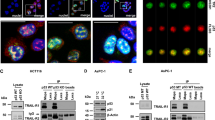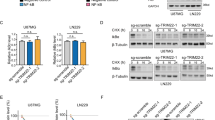Abstract
NORE1A (RASSF5) is a tumor suppressor of the Ras-association domain family (RASSF) that is commonly inactivated in multiple human cancers. However, the molecular mechanism underlying its growth inhibition function remains largely undefined. Here we report that NORE1A antagonizes tumor necrosis factor receptor I (TNFRI) through the assembly of ITCH-mediated destruction complex to suppress TNF-NF-κB signaling and tumorigenesis. Moreover, NORE1A is identified as a transcription target of NF-κB, which directs an apoptotic switch of TNF effect by blocking ITCH interaction with and ubiquitination of BAX. Mechanistically, NORE1A binds directly to TNFRI and ITCH via the C1 and PPXY domains, respectively to facilitate the formation of ITCH-mediated destruction complex followed by ubiquitination-mediated lysosomal degradation of TNFRI. Through this function, NORE1A suppresses TNF-induced NF-κB-mediated transcription of pro-inflammatory and tumor-promoting genes, epithelial-to-mesenchymal transition, invasion and migration of tumor cells, and also debilitates tumor cell activation of macrophage and fibroblast. While NORE1A suppresses TNF receptor-mediated apoptosis, it activates TNF-induced apoptosis through BAX activation by protecting BAX from ITCH binding and ubiquitination. Cytotoxic response to TNF is substantially attenuated in NORE1A-depleted cells and tumors, and NORE1A-induced tumor regression is highly impeded in BAX-depleted tumors. An inverse correlation is shown between NORE1A and TNFRI expression in both cancer cell lines and primary tumors, and NORE1A effect on survival of cancer patients is strongly associated with expression status of ITCH. Collectively, this study uncovers that NORE1A directs a substrate switch of ITCH favoring TNFRI over BAX to terminate TNF signaling and accelerate apoptosis, illuminating the mechanistic consequence of NORE1A inactivation in tumorigenesis.
This is a preview of subscription content, access via your institution
Access options
Subscribe to this journal
Receive 50 print issues and online access
$259.00 per year
only $5.18 per issue
Buy this article
- Purchase on Springer Link
- Instant access to full article PDF
Prices may be subject to local taxes which are calculated during checkout








Similar content being viewed by others
References
Vos MD, Martinez A, Ellis CA, Vallecorsa T, Clark GJ. The pro-apoptotic RAS effector Nore1 may serve as a RAS-regulated tumor suppressor in the lung. J Biol Chem. 2003;278:21938–43.
Hesson L, Dallol A, Minna JD, Maher ER, Latif F. NORE1A, a homologue of RASSF1A tumour suppressor gene is inactivated in human cancers. Oncogene. 2003;22:947–54.
Tommasi S, Zhang X-f, Pfeifer GP, Dammann R, Jin S-G, Avruch J. RASSF3 and NORE1: identification and cloning of two human homologues of the putative tumor suppressor gene RASSF1. Oncogene. 2002;21:2713–20.
van der Weyden L, Adams DJ. The Ras-association domain family (RASSF) members and their role in human tumourigenesis. Biochim Biophys Acta. 2007;1776:58–85.
Chen J, Lui WO, Vos MD, Clark GJ, Takahashi M, Schoumans J, et al. The t(1;3) breakpoint-spanning genes LSAMP and NORE1 are involved in clear cell renal cell carcinomas. Cancer Cell. 2003;4:405–13.
Irimia M, Fraga MF, Sanchez-Cespedes M, Esteller M. CpG island promoter hypermethylation of the Ras-effector gene NORE1A occurs in the context of a wild-type K-ras in lung cancer. Oncogene. 2004;23:8695–9.
Lee CK, Lee J-H, Lee M-G, Jeong S-I, Ha T-K, Kang M-J, et al. Epigenetic inactivation of the NORE1 gene correlates with malignant progression of colorectal tumors. BMC Cancer. 2010;10:577.
Avruch J, Xavier R, Bardeesy N, Zhang X-F, Praskova M, Zhou D, et al. Rassf family of tumor suppressor polypeptides. J Biol Chem. 2009;284:11001–5.
Khokhlatchev A, Rabizadeh S, Xavier R, Nedwidek M, Chen T, Zhang XF, et al. Identification of a novel Ras-regulated proapoptotic pathway. Curr Biol. 2002;12:253–65.
Donninger H, Calvisi DF, Barnoud T, Clark J, Schmidt ML, Vos MD, et al. NORE1A is a Ras senescence effector that controls the apoptotic/senescent balance of p53 via HIPK2. J Cell Biol. 2015;208:777–89.
Ortiz-Vega S, Khokhlatchev A, Nedwidek M, Zhang XF, Dammann R, Pfeifer GP, et al. The putative tumor suppressor RASSF1A homodimerizes and heterodimerizes with the Ras-GTP binding protein Nore1. Oncogene. 2002;21:1381–90.
Calvisi DF, Donninger H, Vos MD, Birrer MJ, Gordon L, Leaner V, et al. NORE1A tumor suppressor candidate modulates p21CIP1 via p53. Cancer Res. 2009;69:4629–37.
Park J, Kang SI, Lee SY, Zhang XF, Kim MS, Beers LF, et al. Tumor suppressor Ras association domain family 5 (RASSF5/NORE1) mediates death receptor ligand-induced apoptosis. J Biol Chem. 2010;285:35029–38.
Balkwill F. Tumour necrosis factor and cancer. Nat Rev Cancer. 2009;9:361–71.
Kraus S, Arber N. Inflammation and colorectal cancer. Curr Opin Pharmacol. 2009;9:405–10.
Talmadge JE, Phillips H, Schneider M, Rowe T, Pennington R, Bowersox O, et al. Immunomodulatory properties of recombinant murine and human tumor necrosis factor. Cancer Res. 1988;48:584–8.
Wang P, Qiu W, Dudgeon C, Liu H, Huang C, Zambetti GP, et al. PUMA is directly activated by NF-kappaB and contributes to TNF-alpha-induced apoptosis. Cell Death Differ. 2009;16:1192–202.
Matthews C, Colburn N, Young M. AP-1 a target for cancer prevention. Curr Cancer Drug Targets. 2007;7:317–24.
Faustman D, Davis M. TNF receptor 2 pathway: drug target for autoimmune diseases. Nat Rev Drug Discov. 2010;9:482–93.
Schneider-Brachert W, Heigl U, Ehrenschwender M. Membrane trafficking of death receptors: implications on signalling. Int J Mol Sci. 2013;14:14475–503.
Ofengeim D, Yuan J. Regulation of RIP1 kinase signalling at the crossroads of inflammation and cell death. Nature reviews. Mol Cell Biol. 2013;14:727–36.
Wertz IE, Dixit VM. Regulation of death receptor signaling by the ubiquitin system. Cell Death Differ. 2010;17:14–24.
Vucic D, Dixit VM, Wertz IE. Ubiquitylation in apoptosis: a post-translational modification at the edge of life and death. Nature Rev Mol Cell Biol. 2011;12:439–52.
Roussos ET, Condeelis JS, Patsialou A. Chemotaxis in cancer. Nat Rev Cancer. 2011;11:573–87.
Colotta F, Allavena P, Sica A, Garlanda C, Mantovani A. Cancer-related inflammation, the seventh hallmark of cancer: links to genetic instability. Carcinogenesis. 2009;30:1073–81.
Hong IS. Stimulatory versus suppressive effects of GM-CSF on tumor progression in multiple cancer types. Exp Mol Med. 2016;48:242–8.
Schneider-Brachert W, Tchikov V, Neumeyer J, Jakob M, Winoto-Morbach S, Held-Feindt J, et al. Compartmentalization of TNF receptor 1 signaling: internalized TNF receptosomes as death signaling vesicles. Immunity. 2004;21:415–28.
Yau R, Rape M. The increasing complexity of the ubiquitin code. Nat Cell Biol. 2016;18:579–86.
Kim H, Vick P, Hedtke J, Ploper D, De Robertis EM. Wnt signaling translocates Lys48-linked polyubiquitinated proteins to the lysosomal pathway. Cell Rep. 2015;11:1151–9.
Fritsch J, Stephan M, Tchikov V, Winoto-Morbach S, Gubkina S, Kabelitz D, et al. Cell fate decisions regulated by k63 ubiquitination of tumor necrosis factor receptor 1. Mol Cell Biol. 2014;34:3214–28.
Foley CJ, Freedman H, Choo SL, Onyskiw C, Fu NY, Yu VC, et al. Dynamics of RASSF1A/MOAP-1 association with death receptors. Mol Cell Biol. 2008;28:4520–35.
Suryaraja R, Anitha M, Anbarasu K, Kumari G, Mahalingam S. The E3 ubiquitin ligase Itch regulates tumor suppressor protein RASSF5/NORE1 stability in an acetylation-dependent manner. Cell Death Dis. 2013;4:565–65.
Martínez-Reza I, Díaz L, García-Becerra R. Preclinical and clinical aspects of TNF-α and its receptors TNFR1 and TNFR2 in breast cancer. J Biomed Sci. 2017;24:1–8.
Tomita Y, Yang X, Ishida Y, Nemoto-Sasaki Y, Kondo T, Oda M, et al. Spontaneous regression of lung metastasis in the absence of tumor necrosis factor receptor p55. Int J Cancer. 2004;112:927–33.
Legler DF, Micheau O, Doucey M-A, Tschopp J, Bron C. Recruitment of TNF receptor 1 to lipid rafts is essential for TNFalpha-mediated NF-kappaB activation. Immunity. 2003;18:655–64.
Tchikov V, Bertsch U, Fritsch J, Edelmann B, Schütze S. Subcellular compartmentalization of TNF receptor-1 and CD95 signaling pathways. Eur J Cell Biol. 2011;90:467–75.
Jones SJ, Ledgerwood EC, Prins JB, Galbraith J, Johnson DR, Pober JS, et al. TNF recruits TRADD to the plasma membrane but not the trans-Golgi network, the principal subcellular location of TNF-R1. J Immunol. 1999;162:1042–8.
D’Alessio A, Al-Lamki RS, Bradley JR, Pober JS. Caveolae participate in tumor necrosis factor receptor 1 signaling and internalization in a human endothelial cell line. Am J Pathol. 2005;166:1273–82.
Hicke L, Dunn R. Regulation of membrane protein transport by ubiquitin and ubiquitin-binding proteins. Annu Rev Cell Dev Biol. 2003;19:141–72.
Kim S, Takahashi H, Lin WW, Descargues P, Grivennikov S, Kim Y, et al. Carcinoma-produced factors activate myeloid cells through TLR2 to stimulate metastasis. Nature. 2009;457:102–6.
Perez D, White E. TNF-alpha signals apoptosis through a bid-dependent conformational change in Bax that is inhibited by E1B 19K. Mol Cell. 2000;6:53–63.
Baillat G, Garrouste F, Remacle-Bonnet M, Marvaldi J, Pommier G. Bcl-xL/Bax ratio is altered by IFNγ in TNFα- but not in TRAIL-induced apoptosis in colon cancer cell line. Biochim Biophys Acta. 2005;1745:101–10.
Johnson BN, Berger AK, Cortese GP, LaVoie MJ. The ubiquitin E3 ligase parkin regulates the proapoptotic function of Bax. Proc Natl Acad Sci U S A. 2012;109:6283–8.
Benard G, Neutzner A, Peng G, Wang C, Livak F, Youle RJ, et al. IBRDC2, an IBR-type E3 ubiquitin ligase, is a regulatory factor for Bax and apoptosis activation. EMBO J. 2010;29:1458–71.
Guan JJ, Zhang XD, Sun W, Qi L, Wu JC, Qin ZH. DRAM1 regulates apoptosis through increasing protein levels and lysosomal localization of BAX. Cell Death Dis. 2015;6:1–12.
Shembade N, Harhaj NS, Parvatiyar K, Copeland NG, Jenkins NA, Matesic LE, et al. The E3 ligase Itch negatively regulates inflammatory signaling pathways by controlling the function of the ubiquitin-editing enzyme A20. Nat Immunol. 2008;9:254–62.
Chang L, Kamata H, Solinas G, Luo JL, Maeda S, Venuprasad K, et al. The E3 ubiquitin ligase itch couples JNK activation to TNFα-induced cell death by inducing c-FLIPL turnover. Cell. 2006;124:601–13.
Azakir BA, Desrochers G, Angers A. The ubiquitin ligase Itch mediates the antiapoptotic activity of epidermal growth factor by promoting the ubiquitylation and degradation of the truncated C-terminal portion of Bid. FEBS J. 2010;277:1319–30.
Choi YB, Shembade N, Parvatiyar K, Balachandran S, Harhaj EW. TAX1BP1 restrains virus-induced apoptosis by facilitating Itch-mediated degradation of the mitochondrial adaptor MAVS. Mol Cell Biol. 2017;37:1–18.
Stieglitz B, Bee C, Schwarz D, Yildiz Ö, Moshnikova A, Khokhlatchev A, et al. Novel type of Ras effector interaction established between tumour suppressor NORE1A and Ras switch II. EMBO J. 2008;27:1995–2005.
Baksh S, Tommasi S, Fenton S, Yu VC, Martins LM, Pfeifer GP, et al. The tumor suppressor RASSF1A and MAP-1 link death receptor signaling to bax conformational change and cell death. Mol Cell. 2005;18:637–50.
Prando ÉdC, Cavalli LR, Rainho CA. Evidence of epigenetic regulation of the tumor suppressor gene cluster flanking RASSF1 in breast cancer cell lines. Epigenetics. 2011;6:1413–24.
Zheng WW, Zhao LD, Wang GX, Kang XC, Qin L, Ji JJ, et al. Promoter methylation and expression of RASSF1A genes as predictors of disease progression in colorectal cancer. Int J Clin Exp Med. 2016;9:2027–36.
Funding
This work was supported in part by National Research Foundation of Korea (Grant numbers NRF-2018R1A2A1A05020236, SGC) and Korea University Grant (K1705811, SGC), Republic of Korea.
Author information
Authors and Affiliations
Contributions
KPK, SIJ, JSL, and KWL performed the experiments. MGL and SGC provided interpretation of the data. KPK and SGC wrote the paper. SGC is responsible for the designing and funding collections. All authors have approved this paper.
Corresponding author
Ethics declarations
Conflict of interest
The authors declare that they have no conflict of interest.
Additional information
Publisher’s note Springer Nature remains neutral with regard to jurisdictional claims in published maps and institutional affiliations.
Rights and permissions
About this article
Cite this article
Ko, KP., Jeong, SI., Lim, JS. et al. NORE1A directs apoptotic switch of TNF signaling through reciprocal modulation of ITCH-mediated destruction of TNFRI and BAX. Oncogene 39, 5675–5689 (2020). https://doi.org/10.1038/s41388-020-01392-y
Received:
Revised:
Accepted:
Published:
Issue Date:
DOI: https://doi.org/10.1038/s41388-020-01392-y



